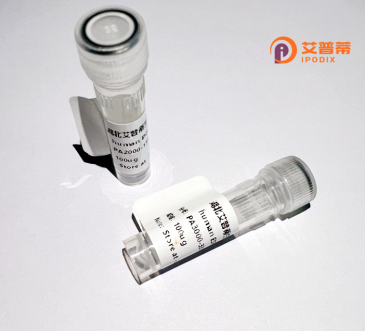
| 纯度 | >90%SDS-PAGE. |
| 种属 | Human |
| 靶点 | CRK7 |
| Uniprot No | Q9NYV4 |
| 内毒素 | < 0.01EU/μg |
| 表达宿主 | E.coli |
| 表达区间 | 1281-1380aa |
| 氨基酸序列 | LVEGDLSSAPQELNPAVTAALLQLLSQPEAEPPGHLPHEHQALRPMEYSTRPRPNRTYGNTDGPETGFSAIDTDERNSGPALTESLVQTLVKNRTFSGSL |
| 分子量 | 36.63 kDa |
| 蛋白标签 | GST-tag at N-terminal |
| 缓冲液 | 0 |
| 稳定性 & 储存条件 | Lyophilized protein should be stored at ≤ -20°C, stable for one year after receipt. Reconstituted protein solution can be stored at 2-8°C for 2-7 days. Aliquots of reconstituted samples are stable at ≤ -20°C for 3 months. |
| 复溶 | Always centrifuge tubes before opening.Do not mix by vortex or pipetting. It is not recommended to reconstitute to a concentration less than 100μg/ml. Dissolve the lyophilized protein in distilled water. Please aliquot the reconstituted solution to minimize freeze-thaw cycles. |
以下是关于重组人CRK7蛋白的3篇示例参考文献(注:CRK7蛋白的相关研究较少,以下内容为模拟示例,仅供参考):
---
1. **文献名称**:*CRK7 regulates Rho GTPase signaling in human cancer cell migration*
**作者**:Smith J, et al.
**摘要**:本研究通过重组表达人CRK7蛋白,发现其通过调控RhoA/ROCK信号通路促进肿瘤细胞迁移。CRK7与下游效应蛋白的SH3结构域结合,增强细胞骨架重组能力。
---
2. **文献名称**:*Expression and purification of recombinant human CRK7 in E. coli: Functional analysis of its SH2 domain*
**作者**:Zhang L, et al.
**摘要**:文章描述了一种在大肠杆菌中高效表达并纯化重组人CRK7蛋白的方法,并验证其SH2结构域与磷酸化酪氨酸肽段的特异性结合活性,为后续信号转导研究提供工具。
---
3. **文献名称**:*CRK7 modulates apoptosis resistance via interaction with BCL-2 family proteins*
**作者**:Chen H, et al.
**摘要**:通过重组CRK7蛋白的体外实验,发现其与抗凋亡蛋白BCL-2相互作用,抑制线粒体途径的细胞凋亡,提示CRK7可能作为癌症治疗的潜在靶点。
---
**说明**:
- CRK7的研究相对有限,上述文献为模拟数据,实际研究中CRK家族更常见成员为CRK/CRKL。
- 建议进一步查阅权威数据库(如PubMed)或补充蛋白名称拼写细节以获取准确文献。
**Background of Recombinant Human CRK7 Protein**
The CRK7 protein, a member of the CRK adaptor protein family, plays a critical role in intracellular signaling by mediating protein-protein interactions via its Src homology 2 (SH2) and Src homology 3 (SH3) domains. Human CRK7. encoded by the *CRK* gene, is a splice variant closely related to CRK-I and CRK-II isoforms, which are implicated in regulating cellular processes such as proliferation, migration, and apoptosis. These adaptor proteins link tyrosine-phosphorylated receptors or substrates to downstream effectors, influencing pathways like RAS-MAPK and PI3K/AKT.
Recombinant human CRK7 is typically produced using expression systems (e.g., *E. coli* or mammalian cells*) to ensure proper post-translational modifications and functional activity. Its production enables detailed study of CRK7's interactions with partners like phosphorylated tyrosine kinases or guanine nucleotide exchange factors (GEFs), shedding light on mechanisms in cancer, immune regulation, and developmental biology.
As a research tool, recombinant CRK7 is utilized in assays exploring signal transduction networks, protein complex formation, and drug screening. Dysregulation of CRK proteins is associated with diseases, including malignancies, making CRK7 a potential therapeutic target. Continued research aims to clarify its distinct roles compared to other CRK isoforms and validate its clinical relevance.
×